Characterization of Strategic Deconflicting Service Impact on Very Low-Level Airspace Capacity
Abstract
:1. Introduction
2. U-Space Strategic Planning and Deconflicting Services
2.1. Airspace Manager and Drone Operator
2.2. Conflict in the U-Space Context
2.3. Strategic Planning and Deconflicting Service
- A flight plan (FP) request issued by a DO, including the flight trajectory and requested launch window (RLW), which is the time window containing the requested take-off time (RTOT), must be submitted to the strategic conflict resolution service before the established submission due time (SDT), the end of submission window (SW), a requirement applicable to all airspace users.
- The USSP employs conflict detection and resolution algorithms to identify any potential conflicts and ascertain the availability of at least one authorized launch window (ALW), which sets the safe take-off time interval without conflicts with previously approved FPs.
- With negligible response delay, the FP is quickly assessed and either approved (if at least one ALW is available) or rejected (if there is no available ALW) before the end of the SW (the SDT). The outcome is then relayed to the DO, with the selected ALW being more concise than the RLW to align with the DO’s preferences.
- Information about the approved FP’s ALW is withheld from the DO until the confirmation due time (CDT), the end of the confirmation window (CW), also known as the RTTA. This interval allows the USSP to potentially adjust the ALW to accommodate new FP approvals that arrive before the end of the CW (the CDT).
- Issuance of the ALW to the DO marks the commencement of the pre-tactical phase, setting the stage for the mission’s tactical phase. DOs must adhere to the guidelines and initiate take-off within the designated ALW, ensuring safe airspace without strategic conflicts, which is loss of separation minima with other scheduled FPs.
3. Simulation
3.1. Purpose of the Simulation Impact Assessment
- Investigate the maximum capacity of the predefined airspace structure.
- 2.
- Verify the impact that each parameter of the strategic deconfliction service has on airspace capacity.
- 3.
- Pursue the trade-off for parameters obtained by comparing simulation results.
- 4.
- Direct future research based on experimental results.
3.2. Simulation Tools
3.3. Simulation Setup
3.4. Simulation Scenarios
4. Results
4.1. Submission Window and Confirmation Window
4.2. Requested Launch Window and Authorized Launch Window
4.3. Hypothesis
4.4. Further Investigation on RLW and ALW
5. Conclusions
5.1. Airspace Manage/Drone Operator Time Constraints
5.2. Future Work
Author Contributions
Funding
Data Availability Statement
Acknowledgments
Conflicts of Interest
References
- Barrado, C.; Boyero, M.; Brucculeri, L.; Ferrara, G.; Hately, A.; Hullah, P.; Martin-Marrero, D.; Pastor, E.; Rushton, A.P.; Volkert, A. U-Space Concept of Operations: A Key Enabler for Opening Airspace to Emerging Low-Altitude Operations. Aerospace 2020, 7, 24. [Google Scholar] [CrossRef]
- Sachs, P.; Dienes, C.; Dienes, E.; Egorov, M. Effectiveness of Preflight Deconfliction in High-Density Uas Operations. Technical Report Altiscope. 2018. Available online: https://storage.googleapis.com/blueprint/TR-009_Preflight_Deconfliction.pdf (accessed on 12 March 2024).
- CORUS-XUAM. ‘Concept of Operations for European U-Space Services—Extension for Urban Air Mobility’, GA 101017682. Available online: https://cordis.europa.eu/project/id/101017682 (accessed on 12 March 2024).
- SESAR Joint Undertaking, U-Space Concept of Operations (ConOPs)—Fourth Edition, Publications Office of the European Union. 2023. Available online: https://data.europa.eu/doi/10.2829/207917 (accessed on 12 March 2024).
- SESAR Joint Undertaking. European U-Space Blueprint. SESAR. 2019. Available online: https://www.sesarju.eu/sites/default/files/documents/reports/U-space%20Blueprint%20brochure%20final.PDF (accessed on 16 March 2024).
- European Union. *Regulation (EU) 2021/664: Establishing a Framework for the U-Space*. Official Journal of the European Union, L 139. 2021. Available online: https://eur-lex.europa.eu/legal-content/EN/TXT/?uri=CELEX%3A32021R0664 (accessed on 18 March 2024).
- BUBBLES, ‘Defining the BUilding Basic BLocks for a U-Space SEparation Management Service’, GA 893206. Available online: https://cordis.europa.eu/project/id/893206 (accessed on 18 March 2024).
- SESAR JU, ‘Supporting Safe and Secure Drone Operations in Europe: A Report of the Consolidated Sesar U-Space Research and Innovation Results’, SESAR JU, Technical Report. 2020. Available online: https://www.sesarju.eu/sites/default/files/documents/reports/U-space%20research%20innovation%20results.pdf (accessed on 18 March 2024).
- Schefers, N.; Carmona, M.A.A.; González, J.J.R.; Nieto, F.S.; Folch, P.; Munoz-Gamarra, J.L. STAM-based methodology to prevent concurrence events in a Multi-Airport System (MAS). Transp. Res. Part C Emerg. Technol. 2020, 110, 186–208. [Google Scholar] [CrossRef]
- Lappas, V.; Zoumponos, G.; Kostopoulos, V.; Shin, H.Y.; Tsourdos, A.; Tantarini, M.; Shmoko, D.; Munoz, J.; Amoratis, N.; Maragkakis, A.; et al. EuroDRONE, A European UTM Testbed for U-Space. In Proceedings of the 2020 International Conference on Unmanned Aircraft Systems, ICUAS, Athens, Greece, 1–4 September 2020. [Google Scholar] [CrossRef]
- Thompson, E.L.; Xu, Y.; Wei, P. A Framework for Operational Volume Generation for Urban Air Mobility Strategic Deconfliction. In Proceedings of the 2023 International Conference on Unmanned Aircraft Systems, ICUAS, Warsaw, Poland, 6–9 June 2023. [Google Scholar] [CrossRef]
- Schefers, N.; González, J.J.R.; Folch, P.; Munoz-Gamarra, J.L. A constraint programming model with time uncertainty for cooperative flight departures. Transp. Res. Part C Emerg. Technol. 2018, 96, 170–191. [Google Scholar] [CrossRef]
- Tang, H.; Zhang, Y.; Mohmoodian, V.; Charkhgard, H. Automated flight planning of high-density urban air mobility. Transp. Res. Part C Emerg. Technol. 2021, 131, 103324. [Google Scholar] [CrossRef]
- Rodriguez, L.; Balampanis, F.; Cobano, J.A.; Maza, I.; Ollero, A. Wind efficient path planning and reconfiguration of UAS in future ATM. In Proceedings of the 12th USA/Europe Air Traffic Management R and D Seminar, Seattle, WA, USA, 27–30 June 2017. [Google Scholar]
- Rios, J.; Aweiss, A.; Jung, J.; Homola, J.; Johnson, M.; Johnson, R. Flight demonstration of unmanned aircraft system (Uas) traffic management (utm) at technical capability level 4. In Proceedings of the AIAA AVIATION 2020 FORUM, Virtual Event, 15–19 June 2020. [Google Scholar] [CrossRef]
- Rios, J. Strategic Deconfliction: System Requirements’, NASA UAS Traffic Management (UTM) Project. 2018. Available online: https://www.researchgate.net/profile/Joseph-Rios-3/publication/332107751_UAS_Traffic_Management_UTM_Project_Strategic_Deconfliction_System_Requirements_Final_Report/links/5ca10ced299bf11169547807/UAS-Traffic-Management-UTM-Project-Strategic-Deconfliction-System-Requirements-Final-Report.pdf (accessed on 3 April 2024).
- Ribeiro, M.; Ellerbroek, J.; Hoekstra, J. Review of conflict resolution methods for manned and unmanned aviation. Aerospace 2020, 7, 79. [Google Scholar] [CrossRef]
- Chin, C.; Gopalakrishnan, K.; Balakrishnan, H.; Egorov, M.; Evans, A. Tradeoffs between Efficiency and Fairness in Unmanned Aircraft Systems Traffic Management. In Proceedings of the 9th International Conference on Research in Air Transportation, Online, 15 September 2020. [Google Scholar]
- Evans, A.; Egorov, M.; Munn, S. Fairness in decentralized strategic deconfliction in utm’. In Proceedings of the AIAA Scitech 2020 Forum, Orlando, FL, USA, 6–10 January 2020. [Google Scholar] [CrossRef]
- Li, S.; Egorov, M.; Kochenderfer, M.J. Optimizing collision avoidance in dense airspace using deep reinforcement learning. In Proceedings of the 13th USA/Europe Air Traffic Management Research and Development Seminar 2019, Vienna, Austria, 17–21 June 2019. [Google Scholar]
- Egorov, M.; Kuroda, V.; Sachs, P. Encounter aware flight planning in the unmanned airspace. In Proceedings of the Integrated Communications, Navigation and Surveillance Conference, ICNS, 2019, Herndon, VA, USA, 9–11 April 2019; 2019. [Google Scholar] [CrossRef]
- Tang, Y.; Xu, Y.; Inalhan, G. Incorporating Optimisation in Strategic Conflict Resolution Service in U-space. In Proceedings of the SESAR Innovation Days, Virtual, 7–9 December 2021. [Google Scholar]
- Ho, F.; Geraldes, R.; Goncalves, A.; Rigault, B.; Oosedo, A.; Cavazza, M.; Prendinger, H. Pre-Flight Conflict Detection and Resolution for UAV Integration in Shared Airspace: Sendai 2030 Model Case. IEEE Access 2019, 7, 170226–170237. [Google Scholar] [CrossRef]
- Groot, J.; Ellerbroek, J.; Hoesktra, J. Enabling Safe and Efficient Separation through Multi-Agent Reinforcement Learning. In Proceedings of the International Conference on Research in Air Transportation (ICRAT), Tampa, FL, USA, 19–23 June 2022. [Google Scholar]
- Gigante, G.; Palumbo, R.; Pascarella, D.; Pellegrini, A.; Duca, G.; Piera, M.; Ramos, J. Support to Design for Air Traffic Management: An Approach with Agent-Based Modelling and Evolutionary Search. Int. J. Aviat. Aeronaut. Aerosp. 2021, 8, 1–21. [Google Scholar] [CrossRef]
- Egorov, M.; Evans, A.; Campbell, S.; Zanlongo, S.; Young, T. Evaluation of UTM Strategic Deconfliction Through End-to-End Simulation. In Proceedings of the 14th USA/Europe Air Traffic Management Research and Development Seminar, ATM 2021, Virtual, 20–23 September 2021. [Google Scholar]
- Schefers, N.; Piera, M.A.; Ramos, J.J.; Nosedal, J. Causal Analysis of Airline Trajectory Preferences to Improve Airspace Capacity. Procedia Comput. Sci. 2016, 104, 321–328. [Google Scholar] [CrossRef]
- EASA Opinion No 01/2020: High-Level Regulatory Framework for the U-Space. Available online: https://www.easa.europa.eu/en/document-library/opinions/opinion-012020 (accessed on 18 March 2024).
- PARTAKE. cooPerative depArtuRes for a compeTitive ATM networK sErvice. GA 699307. Available online: https://cordis.europa.eu/project/id/699307 (accessed on 18 April 2024).
- DACUS, ‘Demand and Capacity Optimisation in U-Space’. GA 893864. Available online: https://cordis.europa.eu/project/id/893864 (accessed on 15 April 2024).
- Munoz-Gamarra, J.L.; Ramos, J.J.; Liu, Z.; Sobejano, A. Impact of USSPs performance in shared U-space volumes. In Proceedings of the SESAR Innovation Days, Seville, Spain, 27–30 November 2023. [Google Scholar]
- Pellegrini, A.; Di Sanzo, P.; Bevilacqua, B.; Duca, G.; Pascarella, D.; Palumbo, R.; Ramos, J.J.; Piera, M.À.; Gigante, G. Simulation-Based Evolutionary Optimization of Air Traffic Management. IEEE Access 2020, 8, 161551–161570. [Google Scholar] [CrossRef]
- Puchol, C.C.; Vélez, N.V.; Tejedor, J.V.B.; Carbó, J.A.V. BUBBLES: A new concept of operations for separation management in the U-space. J. Phys. Conf. Ser. 2023, 2526, 012092. [Google Scholar] [CrossRef]
- Rahman, M.F.; Ellerbroek, J.; Hoekstra, J. Effect of CNS Systems Performance on Autonomous Separation in U-Space. In Proceedings of the International Conference on Research in Air Transportation, Singapore, 1–4 July 2024. [Google Scholar]
- Soeffker, N.; Ulmer, M.W.; Mattfeld, D.C. Stochastic dynamic vehicle routing in the light of prescriptive analytics: A review. Eur. J. Oper. Res. 2022, 298, 801–820. [Google Scholar] [CrossRef]
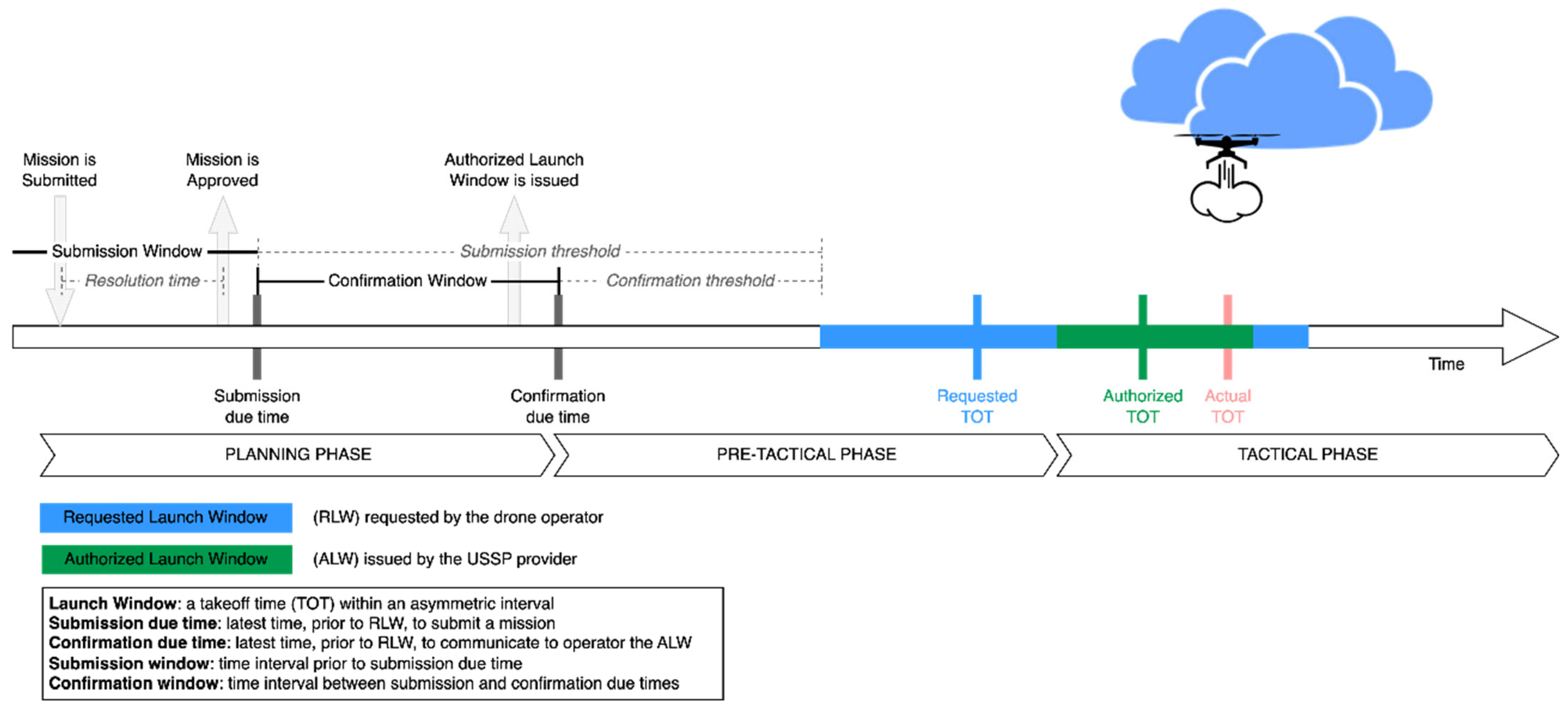

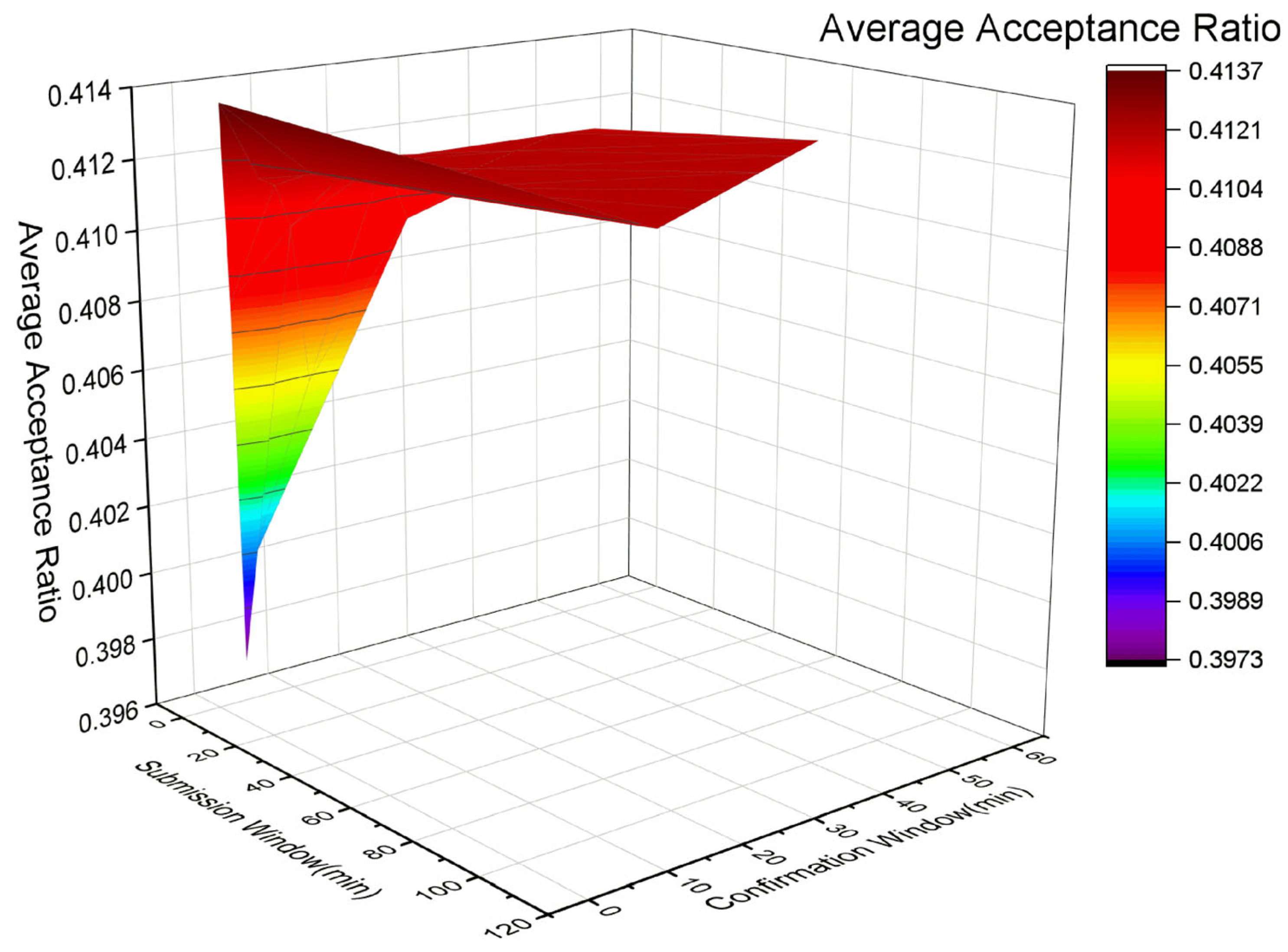
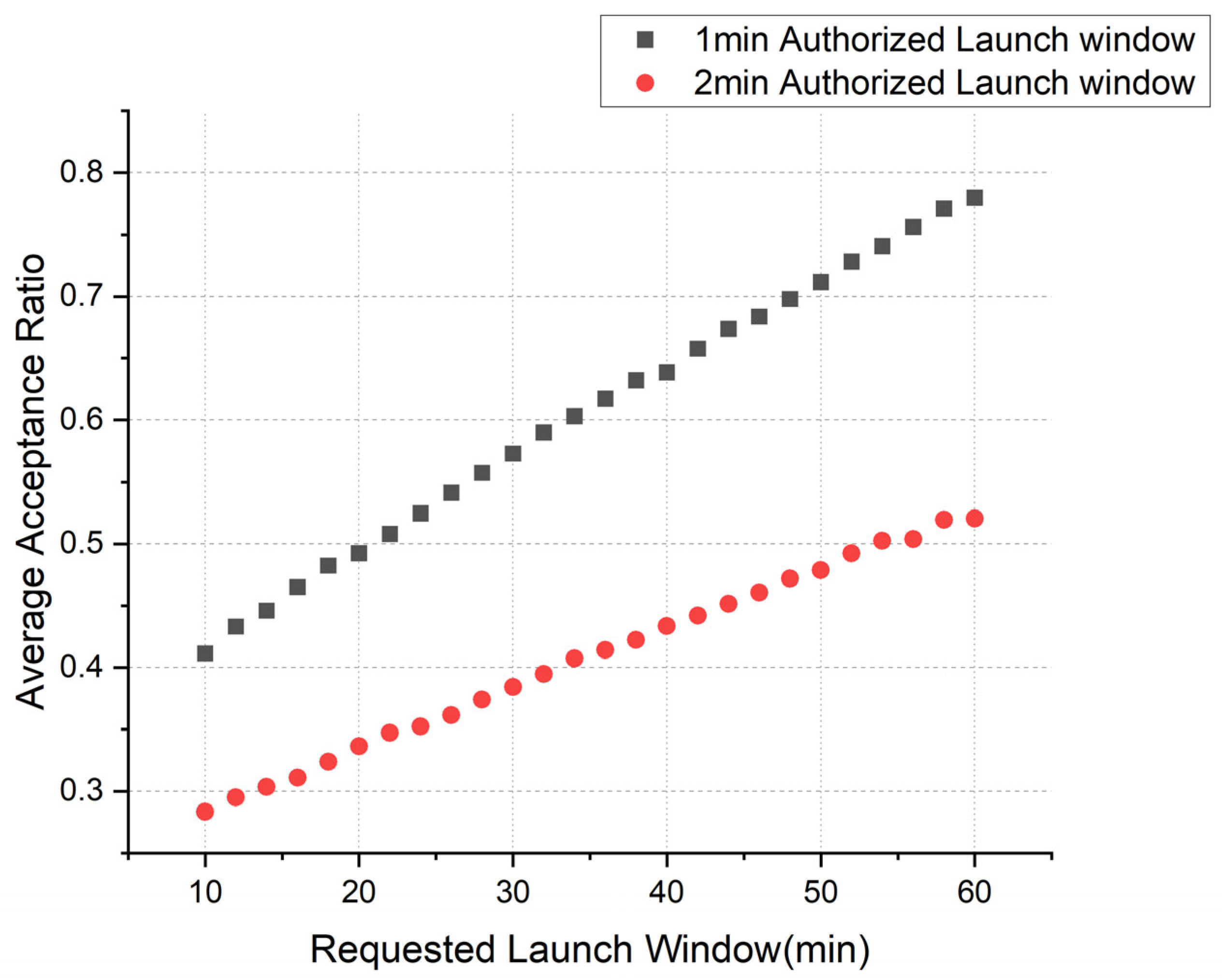
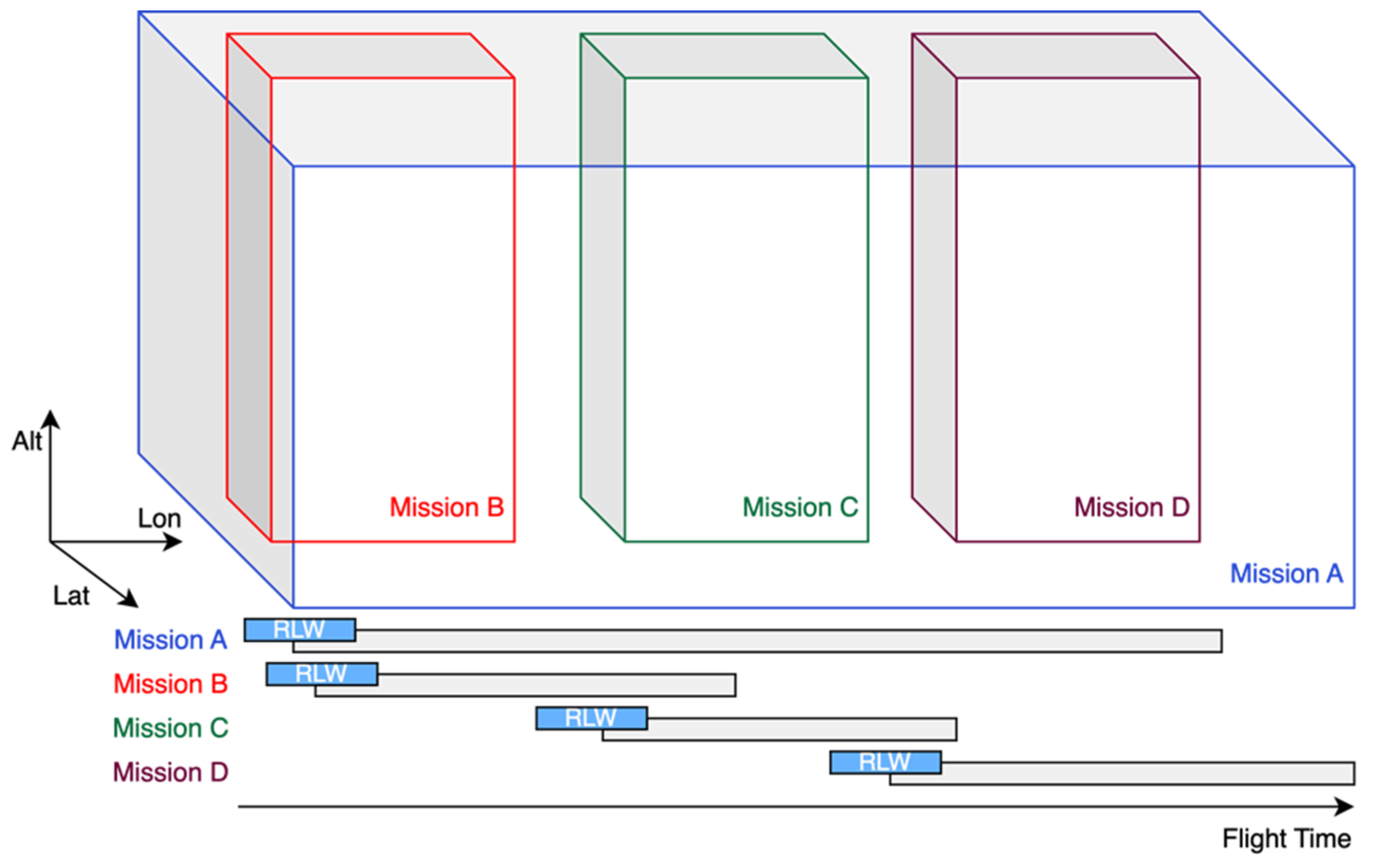
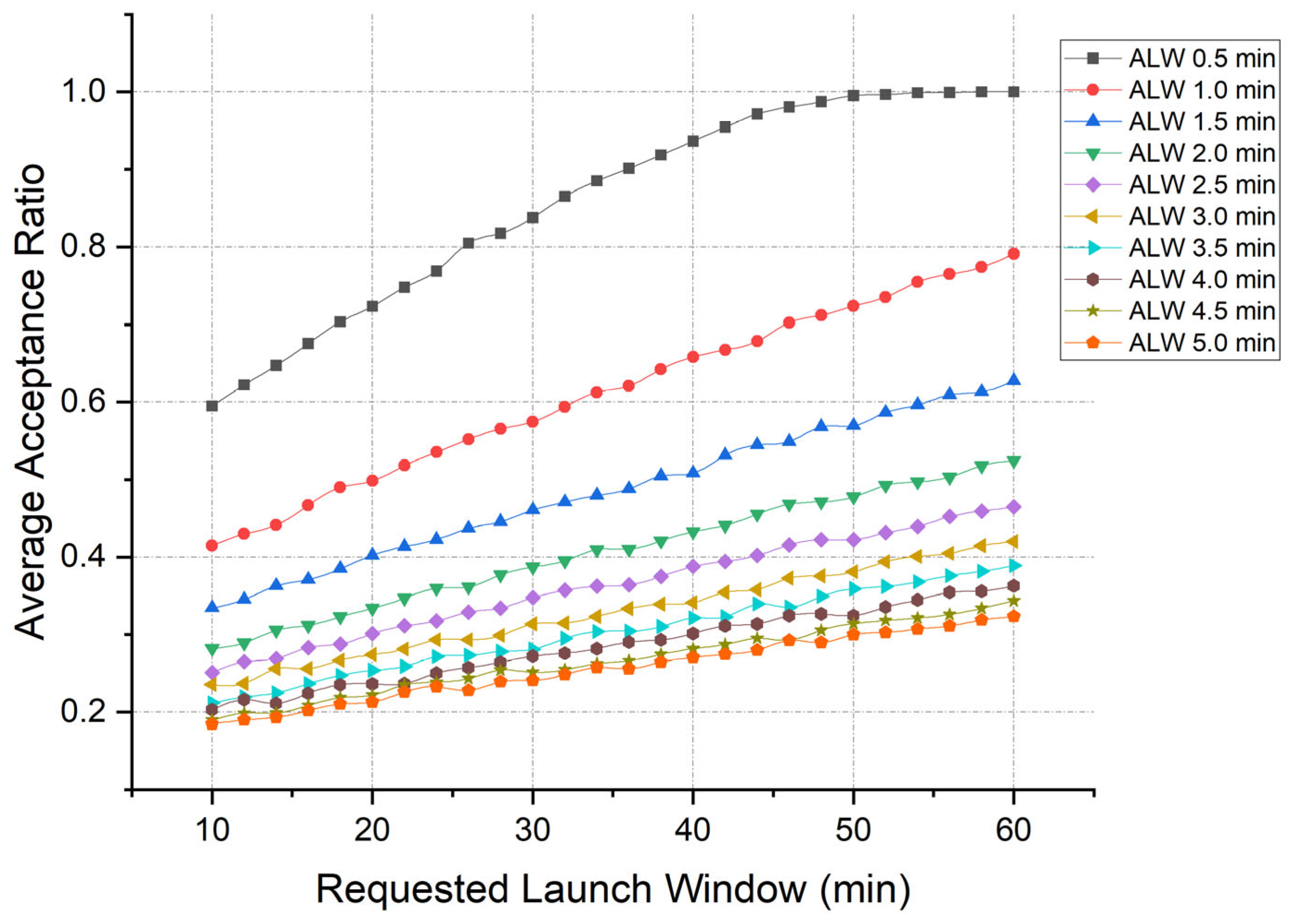
| Time Window | Airspace Manager | Drone Operator |
|---|---|---|
| Submission window (SW) | Earlier | Later |
| Confirmation Window (CW) | Longer | Shorter |
| Requested Launch Window (RLW) | Longer | Shorter |
| Authorized Launch Window (ALW) | Shorter | Longer |
| Simulation Configuration | |
|---|---|
| Demand Density | 100 FPs/h |
| Simulation Time | 1 h |
| Simulation Repeat | 3000 times |
| Airspace Architecture | Corridor |
| Horizontal Separation Minima | 30 m |
| Vertical Separation Minima | 30 m |
| Scenario Configuration | Flight Authorization Interval (Minutes Prior to RLW) | RLW (min) | ALW (min) | |
|---|---|---|---|---|
| SW (min) | CW (min) | |||
| Scenario A.1 | 5 | 1, 2, 3, 4 | 10 | 1 |
| Scenario A.2 | 15 | 5, 10, 14 | ||
| Scenario A.3 | 30 | 5, 10, 15, …, 29 | ||
| Scenario A.4 | 60 | 5, 10, 15, …, 59 | ||
| Scenario A.5 | 120 | 5, 10, 15, …, 119 | ||
| Scenario B.1 | 30 | 5 | 10, 12, 14, …, 60 | 1 |
| Scenario B.2 | 2 | |||
| Scenario Configuration | Flight Authorization Interval (Minutes Prior to RLW) | RLW (min) | ALW (min) | |
|---|---|---|---|---|
| SW (min) | CW (min) | |||
| Scenario C.1 | 30 | 5 | 10, 12, 14, …, 60 | 0.5 |
| Scenario C.2 | 1 | |||
| Scenario C.3 | 1.5 | |||
| Scenario C.4 | 2 | |||
| Scenario C.5 | 2.5 | |||
| Scenario C.6 | 3 | |||
| Scenario C.7 | 3.5 | |||
| Scenario C.8 | 4 | |||
| Scenario C.9 | 4.5 | |||
| Scenario C.10 | 5 | |||
| RLW (min) | ALW (min) | R Square | Formulation |
|---|---|---|---|
| 0.5 | 0.9404 | Y = 0.0085X + 0.5601 | |
| 1 | 0.9969 | Y = 0.0075X + 0.3496 | |
| 10 | 1.5 | 0.9979 | Y = 0.0058X + 0.2812 |
| 12 | 2 | 0.9974 | Y = 0.0049X + 0.2375 |
| 14 | 2.5 | 0.9967 | Y = 0.0042X + 0.2155 |
| 16 | 3 | 0.9971 | Y = 0.0037X + 0.199 |
| … | 3.5 | 0.9958 | Y = 0.0035X + 0.1809 |
| 60 | 4 | 0.9927 | Y = 0.0032X + 0.1737 |
| 4.5 | 0.9941 | Y = 0.003X + 0.1634 | |
| 5 | 0.9948 | Y = 0.0028X + 0.1592 |
Disclaimer/Publisher’s Note: The statements, opinions and data contained in all publications are solely those of the individual author(s) and contributor(s) and not of MDPI and/or the editor(s). MDPI and/or the editor(s) disclaim responsibility for any injury to people or property resulting from any ideas, methods, instructions or products referred to in the content. |
© 2024 by the authors. Licensee MDPI, Basel, Switzerland. This article is an open access article distributed under the terms and conditions of the Creative Commons Attribution (CC BY) license (https://creativecommons.org/licenses/by/4.0/).
Share and Cite
Liu, Z.; Munoz-Gamarra, J.L.; Ramos Gonzalez, J.J. Characterization of Strategic Deconflicting Service Impact on Very Low-Level Airspace Capacity. Drones 2024, 8, 426. https://doi.org/10.3390/drones8090426
Liu Z, Munoz-Gamarra JL, Ramos Gonzalez JJ. Characterization of Strategic Deconflicting Service Impact on Very Low-Level Airspace Capacity. Drones. 2024; 8(9):426. https://doi.org/10.3390/drones8090426
Chicago/Turabian StyleLiu, Zhiqiang, Jose Luis Munoz-Gamarra, and Juan José Ramos Gonzalez. 2024. "Characterization of Strategic Deconflicting Service Impact on Very Low-Level Airspace Capacity" Drones 8, no. 9: 426. https://doi.org/10.3390/drones8090426





